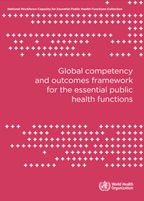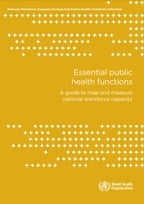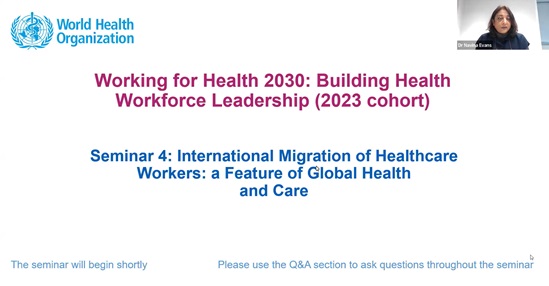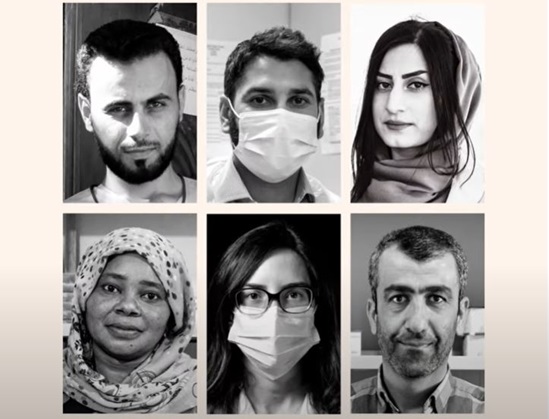Health workforce
Health systems can only function with health workers; improving health service coverage and realizing the right to the enjoyment of the highest attainable standard of health is dependent on their availability, accessibility, acceptability and quality.
WHO estimates a projected shortfall of 10 million health workers by 2030, mostly in low- and lower-middle income countries.
However, countries at all levels of socioeconomic development face, to varying degrees, difficulties in the education, employment, deployment, retention, and performance of their workforce.
The chronic under-investment in education and
training of health workers in some countries and the mismatch between education and employment strategies in relation to health systems and population needs are contributing to continuous shortages. These are compounded by difficulties in deploying
health workers to rural, remote and underserved areas. Moreover, the increasing international migration of health workers may exacerbate health workforce shortfalls, particularly in low- and lower-middle income countries. Human resources for health
information systems are often weak to take stock of selected health workers from the public sector.
In some countries, challenges in universal access to health workers may also result from the lack of capacity by the public sector to absorb the supply of health workers due to budgetary constraints. As a result, some countries face the paradox of health
worker unemployment co-existing with major unmet health needs.
The High-Level Commission on Health Employment and Economic Growth identified six pathways by which investments in the health and social workforce can spur inclusive economic growth. The health workforce has a vital role in building the resilience of communities and health systems to respond to disasters caused by natural or artificial hazards, as well as related environmental, technological and biological hazards and risks. Sixty-seven per cent (67%) of the health and social workforce are women and investing in the health workforce is an opportunity to create decent employment opportunities, in particular for women and youth.
The Global Strategy on Human Resources for Health: Workforce 2030 is the key guiding document with principles and objectives presented below:
- Guiding principles
- Promote the right to the enjoyment of the highest attainable standard of health.
- Provide integrated, people-centred health services devoid of stigma and discrimination.
- Foster empowered and engaged communities.
- Uphold the personal, employment and professional rights of all health workers, including safe and decent working environments and freedom from all kinds of discrimination, coercion and violence.
- Eliminate gender-based violence, discrimination and harassment.
- Promote international collaboration and solidarity in alignment with national priorities.
- Ensure ethical recruitment practices in conformity with the provisions of the WHO Global Code of Practice on the International Recruitment of Health Personnel.
- Mobilize and sustain political and financial commitment and foster inclusiveness and collaboration across sectors and constituencies.
- Promote innovation and the use of evidence.
Working for Health Programme
The Working for Health Programme is a joint partnership between the World Health Organization (WHO), International Labour Organization (ILO) and the Organization for Economic Co-operation and Development (OECD) to expand and transform the health and social workforce to drive inclusive economic growth and achieve the Sustainable Development Goals (SDGs).
Working for Health contributes to universal health coverage and to SDG 3, 4, 5 and 8 (health, education, gender equality, decent work and economic growth) through the Five-Year Action Plan on Health Employment and Inclusive Economic Growth 2017-2021. In 2020, Working for Health supported thirty-two countries and two regional economic areas namely, the Southern African Development Community and the West African Economic and Monetary Union. The Working for Health Programme supports strengthening health workforce data globally through the International Platform on Health Worker Mobility Platform on Health Worker Mobility and Inter-Agency Data Exchange (IADEx).
The Global Health Workforce Network
The WHO led/coordinated network Global Health Workforce Network was established in 2016, following a request by Member States and building on a proposal by the Board of the Global Health Workforce Alliance. The Network operates within WHO as a global mechanism for stakeholder consultation, dialogue and coordination on comprehensive and coherent health workforce policies in support of the implementation of the Global Strategy on Human Resources for Health and the recommendations of the Commission.
Key national and local partners
- ministries of health, education, labour, finance, national planning, gender, youth
- professional associations and trade unions
- regulatory authorities
- private providers
- civil society.
Key international partners
International Labour Organization (ILO), The Organisation for Economic Co-operation and Development (OECD), The World Bank, The United Nations Children's Fund (UNICEF), The European Union
(EU), International NGOs.
















